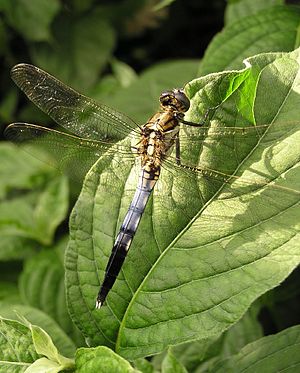Eastern blue arrow
| Eastern blue arrow | ||||||||||||
|---|---|---|---|---|---|---|---|---|---|---|---|---|

Orthetrum albistylum speciosum , male |
||||||||||||
| Systematics | ||||||||||||
|
||||||||||||
| Scientific name | ||||||||||||
| Orthetrum albistylum | ||||||||||||
| ( Selys , 1848) |
The eastern blue arrow ( Orthetrum albistylum ) is a Eurasian dragonfly species from the family of the sailing dragonflies (Libellulidae).
features
The adults reach a body length of 45 to 50 millimeters. This makes them comparable in size to the similar Great Blue Arrow ( Orthetrum cancellatum ), but appear slimmer than this. The sexually mature males have pale blue tires in the middle abdomen, while the end of the body is clearly set off in black. The thorax is brownish, with a light stripe in the middle on the upper side and two pale milky bands on each side. The wing marks are black and relatively large.
Immature, non-colored males and the younger females have a pale yellow-brownish color on the abdomen and have a grid pattern made up of two dark, strong vertical stripes that describe a slight arch on each segment. A distinctive feature of the eastern blue arrow are the usually white abdominal appendages ( cerci ) in both sexes (in some males, however, occasionally also black; in the females the adjacent 10th abdominal segment is also white). Abdominal appendages in white are otherwise only found in Europe by the Eastern and the Zierliche Moosjungfer .
Habitat and Distribution
The eastern blue arrow lives in stagnant and slowly flowing, heat-favored waters. The distribution area extends from the Bay of Biscay in the west to Japan and Taiwan in the east. The more or less closed eastern distribution area begins between south-west Poland and the Balkans , while in the west there is only a narrow band of individual larger populations from east Austria via north Italy , the Swiss plateau, south-west Baden-Württemberg as well as central and south France moves to the Atlantic. Indigenous populations on the edge of the Alps have also existed in Bavaria since the beginning of the 21st century . These presumably come from animals that came from the Po Valley and were able to cross the Alps from Italy with the help of foehn winds . The species is currently showing further spreading tendencies, but is overall a great rarity in Central Europe.
Way of life
The males like to sit on bare spots on the ground, only rarely on plants. They are very fast in flight and usually fly close to the shore. Their behavior corresponds to that of the flat belly ( Libellula depressa ). The males of this species drive away those of the eastern blue arrows when they are found together in bodies of water.
The females lay their eggs by bobbing in flight, flat above the surface of the water. Little is known about the presumably annual development of the larvae .
literature
- Gerhard Jurzitza: The Kosmos dragonfly guide . Franckh-Kosmos Verlags GmbH & Co., Stuttgart 2000, ISBN 3-440-08402-7
- Klaas-Douwe B Dijkstra: Field Guide to the Dragonflies of Britain and Europe. British Wildlife Publishing, 2006, ISBN 0-9531399-4-8
- Höppner, B. & K. Sternberg (2000): Orthetrum albistylum (Sélys, 1848) - Eastern blue arrow. Pp. 469-477. In: Sternberg, K. & R. Buchwald (eds.): Die Libellen Baden-Württemberg. Volume 2: Dragonflies (Anisoptera). Ulmer, Stuttgart, ISBN 3-8001-3514-0
Web links
- Orthetrum albistylum inthe IUCN 2013 Red List of Threatened Species . Posted by: Clausnitzer, V., 2007. Retrieved February 22, 2014.
